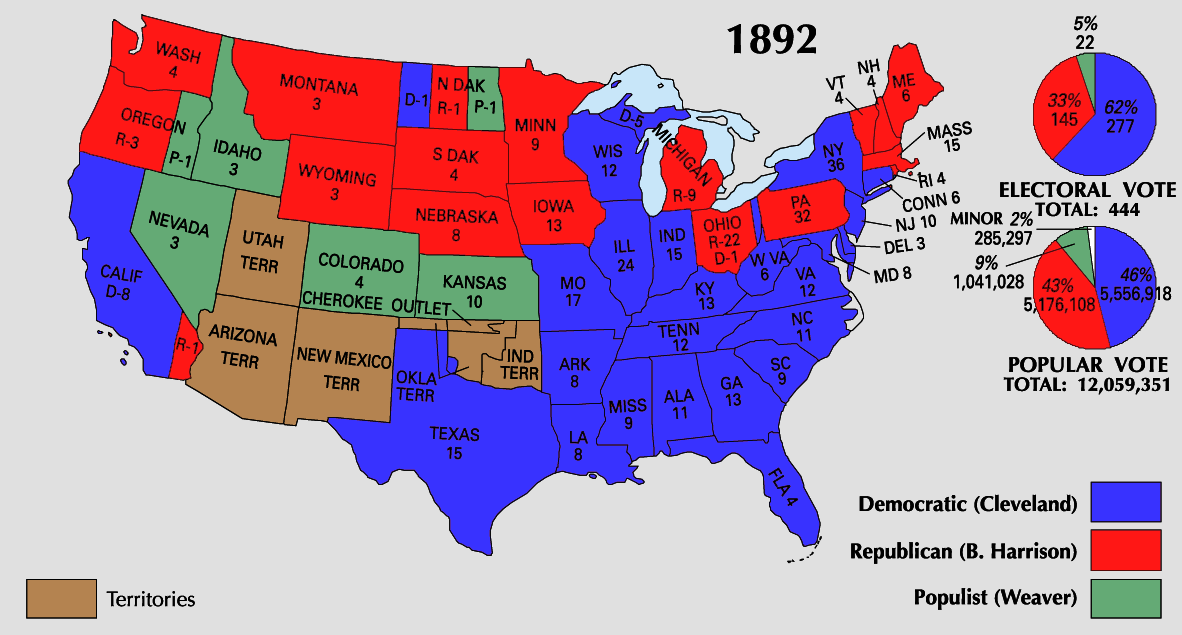- United States presidential election, 1892
Infobox Election
election_name = United States presidential election, 1892
country = United States
type = presidential
ongoing = no
previous_election = United States presidential election, 1888
previous_year = 1888
next_election = United States presidential election, 1896
next_year = 1896
election_date = November 8, 1892
nominee1 =Grover Cleveland
party1 = Democratic Party (United States)
home_state1 =New York
running_mate1 =Adlai E. Stevenson I
electoral_vote1 = 277
states_carried1 = 23
popular_vote1 = 5,556,918
percentage1 = 46.0%
nominee2 =Benjamin Harrison
party2 = Republican Party (United States)
home_state2 =Indiana
running_mate2 =Whitelaw Reid
electoral_vote2 = 145
states_carried2 = 16
popular_vote2 = 5,176,108
percentage2 = 43.0%
nominee3 = James Weaver
party3 = Populist Party (United States)
home_state3 =Iowa
running_mate3 =James Gaven Field
electoral_vote3 = 22
states_carried3 = 5
popular_vote3 = 1,041,028
percentage3 = 8.5%
map_size = 350px
map_caption = Presidential election results map. Red denotes states won by Harrison/Reid, Blue denotes those won by Cleveland/Stevenson Light green denotes those won by Weaver/Field. Numbers indicate the number of electoral votes allotted to each state.title = President
before_election =Benjamin Harrison
before_party = Republican Party (United States)
before_color = FF3333
after_election =Grover Cleveland
after_party = Democratic Party (United States)
after_color = 3333FFThe United States presidential election of 1892 was held on November 8, 1892.New York 'sGrover Cleveland returned to defeat incumbent PresidentBenjamin Harrison , becoming the only person to be elected to non-consecutive presidential terms. Cleveland, who had won the popular vote against Harrison in 1888, won both the popular and electoral vote in the rematch.Cleveland also became the first Democrat to be nominated by his party three consecutive times, a distinction that would be equaled only by
Franklin D. Roosevelt in 1940 and then exceeded by him in 1944. AlthoughWilliam Jennings Bryan was nominated for a third time in 1908 it was not consecutive with his two other nominations in 1896 and 1900.Nominations
Republican Party nomination
Republican candidates
*
Benjamin Harrison , President of the United States fromIndiana
*James G. Blaine , former U.S. Secretary of StateMaine
*William McKinley , U.S. governor ofOhio Candidates gallery
Indiana 'sBenjamin Harrison was easily renominated for President in Minneapolis, but his choice was not unanimous. Harrison received 536 delegate votes to secure the nomination, but former nominee James Gillespie Blaine ofMaine received 183 delegates, and future nominee and OhioanWilliam McKinley finished third with 182 delegates. "New York Tribune " editorWhitelaw Reid was unanimously chosen to replace Vice President Levi Morton on the ticket.Democratic Party nomination
Democratic candidates
*
Grover Cleveland , FormerPresident of the United States fromNew York
*David B. Hill , U.S. senator fromNew York
*Horace Boies , U.S. governor ofIowa
* John M. Palmer, U.S. senator fromIllinois Candidates gallery
For the third consecutive time,
Grover Cleveland was chosen as the Democratic Party's Presidential nominee, receiving 618 delegate votes inChicago to defeatDavid B. Hill (who received 114 delegates) andHorace Boies (103). Adlai E. Stevenson (whose grandson, Adlai II, would twice be the party's Presidential nominee in the 1950s) was chosen as the party's Vice Presidential nominee by 652 delegates, defeatingIsaac P. Gray (who received 343 delegate votes),John L. Mitchell (45) andHenry Watterson (26).Other nominations
Three other parties fielded candidates for the election. The Prohibition Party nominated
John Bidwell for President andJames Cranfill for Vice President. Two other parties made their first attempts at theWhite House : the Populist Party, who placedJames Weaver and James Field on their ticket, and the Socialist Labor Party, who choseSimon Wing andCharles Matchett as their standard bearers.General election
Campaign
As in 1888, the tariff issue was a key difference between free market Democrats and protectionist Republicans. Another issue, though, was the
gold standard , with the Populists putting their chief emphasis on demanding higher inflation through increased coinage of silver, which would benefit debtors such as Southern and Western farmers. Cleveland's strong adherence to "hard" money gained him more backing from Eastern bankers and business.Another issue was labor, with a major strike at Carnegie Steel ending with fighting between picketers and armed guards that galvanized labor opposition to the Republican administration.
While the Populists did take several states in the West, the South remained Democratic and the industrial Northeast turned out for Cleveland as well, giving him a solid victory and the Democrats control of both houses of Congress.
Results
44 States participated in this election, as six states—
North Dakota ,South Dakota ,Montana ,Washington ,Idaho , andWyoming —had joined the Union in 1889-90.Source (Popular Vote): Leip PV source 2| year=1892| as of=July 27, 2005
Source (Electoral Vote): National Archives EV source| year=1892| as of=July 31, 2005
Media
See also
*
American election campaigns in the 19th century
*History of the United States (1865-1918)
*History of the United States Democratic Party
*History of the United States Republican Party
*Lies My Teacher Told Me, page 158, James W. Loewen External links
* [http://geoelections.free.fr/USA/elec_comtes/1892.htm 1892 popular vote by counties]
* [http://www.multied.com/elections/1892state.html 1892 State-by-state Popular vote]
* [http://www.ourcampaigns.com/RaceDetail.html?RaceID=58108 Overview of 1892 Democratic National Convention]
* [http://www.msu.edu/~sheppa28/elections.html#1892 How close was the 1892 election?] - Michael Sheppard, Michigan State UniversityReferences
* [http://www.questia.com/PM.qst?a=o&d=8541336 online edition]
*
*
*
* [http://www.questia.com/PM.qst?a=o&d=24451028 online edition]
*
*
*
* Rhodes; James Ford. "History of the United States from the Compromise of 1850 to the Mckinley-Bryan Campaign of 1896." Volume: 8; 1920. ch 17 [http://www.questia.com/PM.qst?a=o&d=99566406 online edition]
* Loewen,James. "Lies My Teacher Told Me" page 158Navigation
Wikimedia Foundation. 2010.

